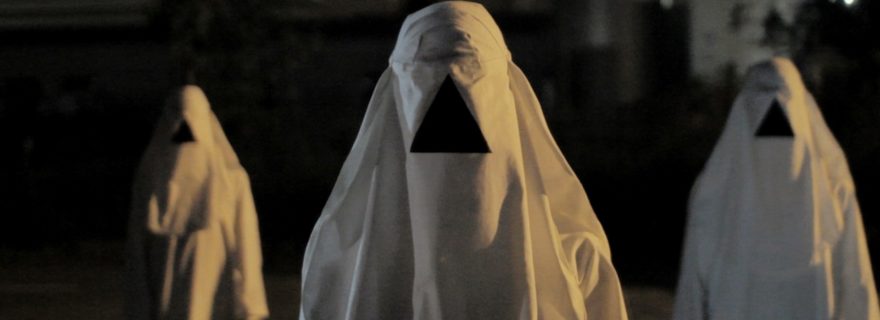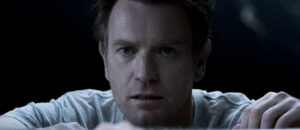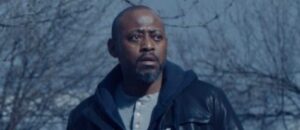'The Void'
Movie Rating:
3.5
For those who love the more serious and deranged end of the 1980s horror movie spectrum, ‘The Void’ will play as a welcome and gruesome return to a bygone era. Produced by members of the filmmaker collective Astron-6, the film retains the group’s horror geek nerdery while ditching the campy comedy. It works, even if it’s a little less clever than 2014’s ‘The Editor‘.
Like so many horror flicks, ‘The Void’ opens on a lonely country road. A cop named Daniel Carter (Aaron Poole) picks up a drug addled lowlife (Evan Stern) and takes him to the local hospital. The building is severely understaffed since it’s so late. Carter runs into his estranged wife (Kathleen Munroe) who’s working as a nurse, along with the respected head doctor (Kenneth Welsh). Things are juuuust about to get awkward between the couple regarding their past when the creepiness begins. A mysterious cult of hooded figures with triangles over their faces surround the building and tentacle creatures start appearing inside. Other characters pop up looking for salvation – varying from a pregnant teen (Grace Munro) to a gruff state trooper (Art Hindle, Can-Con horror icon), and a pair of father and son vigilantes (Daniel Fathers and Mik Byskov) who plan on hunting this cult down. From there, everyone is trapped and things are about to get bad. Bloody bad. Interdimensional horror bad.
Like all Astron-6 productions, ‘The Void’ wears its influences on its sleeve. The big one for co-directors Jeremy Gillespie and Steven Kostanski (‘Manborg’ and digital art direction for everything from ‘Pacific Rim’ to ‘Pixels’) is John Carpenter. The movie is a mixture of the apocalyptic existential mindfuck of ‘Prince of Darkness’, the Lovecraftian nightmare of ‘The Thing’, and the isolated siege suspense of ‘Assault on Precinct 13 ‘(plus a little Clive Barker and Lucio Fulci thrown in for good measure). The atmosphere is impressive. Dread seeps in from the opening frames and only gets worse. Like Carpenter at his best, the directors shoot in wide 2.35:1 frames, used to create a powerful sense of claustrophobia that can feel overwhelming. When the scares come, they live up to the build-up.
Given Gillespie and Kostanski’s background in effects, it should come as no surprise that the visuals here are stunning. The monsters are surrealistic rubber nightmares with tentacles that slither under the skin. (They’re all carefully shot through shadow for maximum power. You might never be quite sure what you’re staring at, which is part of the deeply unsettling spell the movie casts.) As the cult horror reaches apocalyptic levels, the pair combine miniatures and CGI to create an alternate plane of reality even more foreboding than what came before.
The scares cut deeper because the filmmakers never over-explain their mysteries. At times, this can feel mildly frustrating since all the horrors and mythology remain out of reach from the first subtle scare to the Grand Guignol finale. It’s true of the strain of horror that the filmmakers are recreating, and while that’s not for everyone, those who adore being teased and horrified by the unknown will be in genre heaven (or hell, your choice).
I haven’t mentioned the cast because acting isn’t really the film’s greatest virtue. That’s not to say that anyone gives a poor performance. It’s just the nature of the Carpenter-esque production that everyone performs in muted tones, adding to the uneasy atmosphere. That also means that this isn’t the most human movie. Everything in the production is designed in service of the atmosphere and impact. For those who get lost in the phantasmagorical nightmare, it won’t matter. However, those folks might be mildly put off by the way the filmmakers don’t quite reach the perversely sexualized nightmares of movies like ‘From Beyond’ or ‘The Beyond’ that Gillespie/Kostanski clearly revere.
Even so, anything negative to be said about ‘The Void’ falls into the category of nitpicking, or unfair comparisons to genre influences. That stuff is valid, but not particularly important. The good news is that the film lives up to its many influences and delivers a particular brand of visceral/psychological/mythic horror that has been absent for too long. This is another leap forward for the Astron-6 gang, proving that they can succeed in genre filmmaking without any of their typical irony. Hopefully it won’t be long before they strike again. They’re well on their way to becoming the type of sick genre masters that they emulate so freely.




Chaz Dumbaugh
Bah, this is top of my list to see, when the hell is it coming out so I can? So lucky you are to be seeing this stuff when you do!
Chaz Dumbaugh
Went looking, On Demand April 7th……SO CANT WAIT! 🙂
Chaz Dumbaugh
Also looks like there is no Bluray planed for this either, at least according to what they said on their facebook page in response to someone who asked about owning it, only for indiegogo backers? I hope that changes because this will be one I have to own from the looks of it
Chris B
It’s getting a region B release from some british distributor apparently. Not ideal but it’s something.
Chris B
It’s up for pre-order on Amazon UK
http://www.amazon.co.uk/exec/obidos/ASIN/B01N4WDBLQ/panandscathed-20
Chris B
Holy fucking shit I’m excited to see this! It’s playing for one night only in my city on a Friday and it’s a licensed event so no minors and they’re servin’ beers in the theater. Gonna be an epic good time!
EM
In the meantime, I see that this weekend a theater around here is showing The Blackcoat’s Daughter, which Phil reviewed positively when it was known as February. I might give it a shot.
Phil
Oh yeah! That is finally coming out. It’s very creepy and we’ll made, but also a bit ponderous. Well worth a peak though.
EM
I did go see The Blackcoat’s Daughter a.k.a. February. I agree with your review for the most part. The sole significant problem I have with the film is that the ending feels insufficient. The real payoff comes earlier, as the storylines’ connections become clear. But the film has to end somewhere, and the overall experience feels like a trip to nowhere special. Fortunately, the journey to that place is special. I think rewatchability is hampered more by the lackluster ending than by knowledge of the film’s secrets. (Indeed, I suspect a second viewing, at least, would be enhanced by a greater appreciation of the puzzle pieces.) I’d still recommend the film to those who enjoy mystery and filmcraft, suffused with macabre flavor.